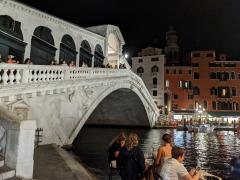 I call this a deep-dive because Lorna and I had been here twice before on very limited visits, so this was our opportunity to fill in the gaps in our knowledge and experience. We were joined by our friends Owen and Brigitte from Nuremberg and we really covered a lot of ground! From a foodie angle, the trip was a smash success, where I got to try a variety of Venetian specialty dishes and see some ingredients that hitherto I had only read about. We saw art and architecture, bustling piazzas and quiet side streets, day-time and night-time. It was two busy and memorable days!
I call this a deep-dive because Lorna and I had been here twice before on very limited visits, so this was our opportunity to fill in the gaps in our knowledge and experience. We were joined by our friends Owen and Brigitte from Nuremberg and we really covered a lot of ground! From a foodie angle, the trip was a smash success, where I got to try a variety of Venetian specialty dishes and see some ingredients that hitherto I had only read about. We saw art and architecture, bustling piazzas and quiet side streets, day-time and night-time. It was two busy and memorable days!
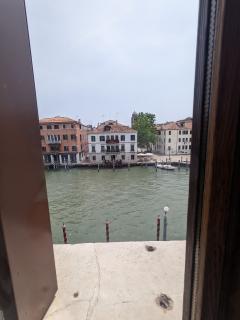 We flew into Venice Marco Polo airport (VCE), arriving at 11:35, and we took a water taxi across the lagoon to our hotel on the Grand Canal in Cannaregio. We stayed at the fancy Hotel Principe for a few reasons, two of which did not work out as planned:
We flew into Venice Marco Polo airport (VCE), arriving at 11:35, and we took a water taxi across the lagoon to our hotel on the Grand Canal in Cannaregio. We stayed at the fancy Hotel Principe for a few reasons, two of which did not work out as planned:
- The hotel website boasts a few onsite restaurants, including the high-end Ristorante Sivoli, which claims "The dishes proposed are inspired by tradition and local products with seasonal ingredients..." so of course I was ready to book a fancy dinner there. Except the restaurant closed for Covid and has not yet reopened!
- The hotel is a short distance from the main train station and jus over a footbridge from the huge cluster of parking garages, bus and taxi stands, and car rental offices. We knew we would leave Venice by car, so proximity to the car rental office was key... but it's closed permanently!
So that means that we could have stayed anywhere, dined anywhere, and rented the car at the airport, as I ended up doing anyway. The first lesson of vacationing in Italy is that however carefully you plan, things still go wrong sometimes.
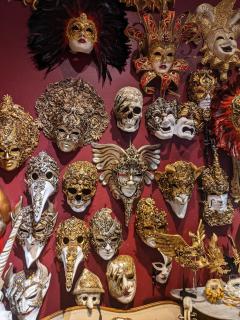 But everything else was wonderful! Of course the shopping is legendary. Venice is known for the fancy masks used during Carnevale, and every souvenir shop has cheap plastic ones from China, but you can find good handmade local masks too; these are at the Atelier Marega.
But everything else was wonderful! Of course the shopping is legendary. Venice is known for the fancy masks used during Carnevale, and every souvenir shop has cheap plastic ones from China, but you can find good handmade local masks too; these are at the Atelier Marega.
Venice is also known for the famous Murano glass, made on the nearby island of Murano for centuries. Again you can find cheap machine-made glass in every souvenir shop, but the best Murano makers have their own shops and contracts with shops in the city where you can find some marvellous pieces. Fortunately your purchases can be shipped home directly, at a significant cost but it's better than worrying about breaking a treasure in your luggage. We found the best shopping in the San Marco and the northern end of the San Polo neighborhoods.
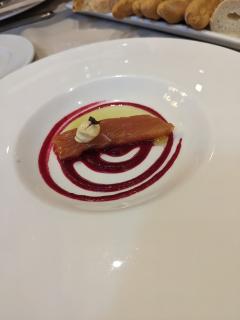 Of course the food was spectacular. I'll go into more detail below, but for not I want to mention that there's great competition in Venice among the restaurants, and fresh fish and produce are readily available, so wherever you are you can find a good meal at a fair price. Even with a tough crew like ours (including a vegetarian) we had no trouble finding memorable meals when we wanted them, and casual bites when that's all we needed.
Of course the food was spectacular. I'll go into more detail below, but for not I want to mention that there's great competition in Venice among the restaurants, and fresh fish and produce are readily available, so wherever you are you can find a good meal at a fair price. Even with a tough crew like ours (including a vegetarian) we had no trouble finding memorable meals when we wanted them, and casual bites when that's all we needed.
This image is of an amuse-bouche that as served at the start of a fabulous lunch at the Bistrot di Venise in San Marco. The effort that goes into presentation is not reserved for places boasting Michelin stars; it seems that every fine restaurant takes great pride in not only making the food to a high degree of excellence, but also presenting it in a way that reminds the diner that "we're not in Kansas anymore".
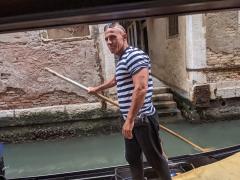 Of course it isn't just the food that brings a sense of being in someplace special. When you look out the restaurant window as a gondolier sails past, you know you're not in New England. The streets are narrow, too narrow for cars, so deliveries are made by boat, and by men pushing two-wheeled carts with adaptations for going over stepped footbridges. The canals are everywhere, and over them are arched footbridges high enough to permit various vessels to sail beneath. This is important to remember if you select a hotel that will require moving your luggage a long distance!
Of course it isn't just the food that brings a sense of being in someplace special. When you look out the restaurant window as a gondolier sails past, you know you're not in New England. The streets are narrow, too narrow for cars, so deliveries are made by boat, and by men pushing two-wheeled carts with adaptations for going over stepped footbridges. The canals are everywhere, and over them are arched footbridges high enough to permit various vessels to sail beneath. This is important to remember if you select a hotel that will require moving your luggage a long distance!
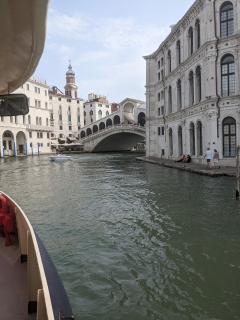 The architecture is amazing, of course. The Grand Canal is lined with fine palazzi that are now hotels, museums, and (very expensive) private homes. At about the midpoint, the mighty Rialto bridge, with dozens of little shops on it, crosses the Grand Canal between the San Marco and San Polo regions. Here and there jutting into the Grand Canal are "bus stops" for the vaporetto water buses that travel the length of the Grand Canal all day. Behind the canalside palaces are large squares with grand churches, some of which are now museums, or museums with part-time church services. Smaller canals connect these areas to the Grand Canal. Around the squares are shops and caffes with outdoor seating that are great for people-watching. There are not a lot of places to sit and relax without spending a few euros on a gelato or a cold drink, but on the other hand it's important to stay hydrated!
The architecture is amazing, of course. The Grand Canal is lined with fine palazzi that are now hotels, museums, and (very expensive) private homes. At about the midpoint, the mighty Rialto bridge, with dozens of little shops on it, crosses the Grand Canal between the San Marco and San Polo regions. Here and there jutting into the Grand Canal are "bus stops" for the vaporetto water buses that travel the length of the Grand Canal all day. Behind the canalside palaces are large squares with grand churches, some of which are now museums, or museums with part-time church services. Smaller canals connect these areas to the Grand Canal. Around the squares are shops and caffes with outdoor seating that are great for people-watching. There are not a lot of places to sit and relax without spending a few euros on a gelato or a cold drink, but on the other hand it's important to stay hydrated!
 Beyond the squares are the quiet residential alleys and numerous side canals. Most Venetians in the old city (there's also a bustling modern seaport city at the other end of the Tronchetto bridge) live in apartments. I looked at some real estate ads and the prices were not as crazy as you might expect for such a unique jewel of a city, but there are an awful lot of drawbacks to life in Venice, too. You have to really want it.
Beyond the squares are the quiet residential alleys and numerous side canals. Most Venetians in the old city (there's also a bustling modern seaport city at the other end of the Tronchetto bridge) live in apartments. I looked at some real estate ads and the prices were not as crazy as you might expect for such a unique jewel of a city, but there are an awful lot of drawbacks to life in Venice, too. You have to really want it.
I found it fascinating to think about life as a homeowner in Venice. What are home upkeep costs like? How do you get a new mattress, or a case of Diet Pepsi? How nonstandard is the plumbing or the locks? If you need an ambulance, is it a pushcart and a fast boat? And if you want to fix up your balcony what's it like getting approval from the Historic District Commission in a city that was founded in 697 AD?
On our 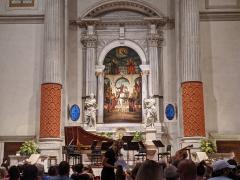 second evening we attended a concert of music by Vivaldi and Corelli by a group affiliated with the museum of music, with period instruments. It was in the church of San Vidal, not far from the Grand Canal in the southwestern corner of the San Marco region. Venice has a long history of musical excellence and innovation, and a very active community of both musicians and patrons, as well as many fine performance venues. This show was about 90 minutes long, with a 20-minute intermission. We were hot, so during the intermission Lorna and I went up to a gelateria in a nearby piazza for bottled water to bring back. We were struck by the magic of the evening, on a break from the music, in a piazza with a statue in the middle and people everywhere enjoying the evening.
second evening we attended a concert of music by Vivaldi and Corelli by a group affiliated with the museum of music, with period instruments. It was in the church of San Vidal, not far from the Grand Canal in the southwestern corner of the San Marco region. Venice has a long history of musical excellence and innovation, and a very active community of both musicians and patrons, as well as many fine performance venues. This show was about 90 minutes long, with a 20-minute intermission. We were hot, so during the intermission Lorna and I went up to a gelateria in a nearby piazza for bottled water to bring back. We were struck by the magic of the evening, on a break from the music, in a piazza with a statue in the middle and people everywhere enjoying the evening.
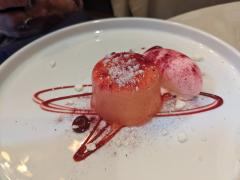 Now about that food...
Now about that food...
Marco Polo let the djinn out of the lamp when he went to far Cathay 750 years ago. Trade between the far East and the Mediterranean blossomed, and Venice was well-positioned to dominate that trade. Of course traders have to eat, and they crave the tastes of home, so soon Venetians were introduced to noodles and a great variety of spices, upon which they soon learned to make a fortune... and a cuisine.
Venetian cuisine is unlike that anywhere else, in Italy or in the world. I'll flag specifically Venetian recipes on the blog so you can see easily just how offbeat and delicious it is!
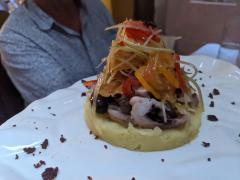 We had two fine meals - no, every meal was fine, but we had two memorable, expensive, carefully-planned, entirely dream-worthy meals.
We had two fine meals - no, every meal was fine, but we had two memorable, expensive, carefully-planned, entirely dream-worthy meals.
Regular readers of these pages know that I am not one of those cooking writers for whom everything the "absolute bestestest thing evah!!!" They rhapsodize about three-bean salad and positively orgasm over fried chicken, because some algorithm says more !! means more readers and more "influence". I have a day-job, I'm a technical writer, and for 30 years my career has been about reporting facts accurately and succinctly. Exclamation points make me twitch, and marketing writing is for another kind of writer.
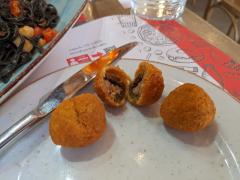 Well, I'm going to get excited about the food on this trip and especially in Venice (and Aosta), but it's warranted. I haven't lost my mind. No extra !!!, I promise.
Well, I'm going to get excited about the food on this trip and especially in Venice (and Aosta), but it's warranted. I haven't lost my mind. No extra !!!, I promise.
Of course, not everything noteworthy was superlative. Here we see some Olive all'Ascolano, a popular snack originating from (and AFAIK still limited to some nameless factory in) the Marche region. These are big green olives, pitted and filled with a savory meat filling, then breaded and deep fried. There's no art to it, but I saw them in many places in northern Italy, especially in the east. I guess they serve the same purpose as mozzarella fingers in these parts. They're terribly time-consuming to make, so I abandoned that recipe early in my project on Italian cuisine. I'm sure there's a factory somewhere that makes them with machines by the pallet-load for resale, but I haven't found it yet. I could totally see them catching on here, maybe led by Olive Garden and their formidable marketing machine!
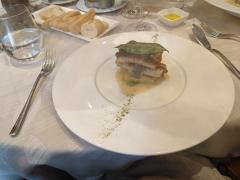 On the other hand, here's the "Eels on the Altar", a tradition from the Murano glassblowers who would have dinner by roasting inexpensive eels on bay leaves in their kilns as they cooled after a day's work. This was on the historical menu (how awesome is that?) at Bistrot di Venise, in San Marco. I had read about it and cooked it "by the book" but how do you know if you got it right until you try it by someone who knows it? This was served under a glass bell-dome filled with smoke and removed before me at the table. That's something you don't see on Cape Cod!
On the other hand, here's the "Eels on the Altar", a tradition from the Murano glassblowers who would have dinner by roasting inexpensive eels on bay leaves in their kilns as they cooled after a day's work. This was on the historical menu (how awesome is that?) at Bistrot di Venise, in San Marco. I had read about it and cooked it "by the book" but how do you know if you got it right until you try it by someone who knows it? This was served under a glass bell-dome filled with smoke and removed before me at the table. That's something you don't see on Cape Cod!
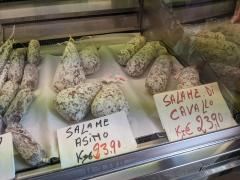 It is a statement sad but true for *all* involved: when you're as awesome as Venice is, there's always a new boss-in-waiting. Despite its foodie wealth, Venice is easily beseiged, blockaded by sea and by land. When times were most dire, the Good Lord provided the bounty of the sea... But when they needed meat, they saved the milk-producers and turned to the horses and donkeys - thus the salame asino (donkey) and cavallo (horse) that you see here. I didn't buy it; I'm not that interested in the subtle differences between artiodacyl flesh and that of perissodactyls, after it's been peppered, herbed, dried, and aged.
It is a statement sad but true for *all* involved: when you're as awesome as Venice is, there's always a new boss-in-waiting. Despite its foodie wealth, Venice is easily beseiged, blockaded by sea and by land. When times were most dire, the Good Lord provided the bounty of the sea... But when they needed meat, they saved the milk-producers and turned to the horses and donkeys - thus the salame asino (donkey) and cavallo (horse) that you see here. I didn't buy it; I'm not that interested in the subtle differences between artiodacyl flesh and that of perissodactyls, after it's been peppered, herbed, dried, and aged.
I see it this way: nobody kills a steer for its liver or omasum, it's slaughtered for many other products, and the liver and tripe are byproducts of negiligible value on the trading floor. It's harder to sell an old horse or ass at auction, and my dollars could maybe possibly make it worthwhile for old Bessie to end her days in various stewpots rather than in some pretty pasture. I won't be a part of building a market for dead animals that doesn't already exist.
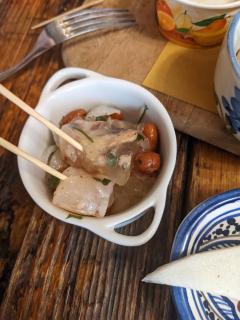 Then we have the Nervetti. This was in a fish place (I Compari) by a fish and produce market. There's no fish in it.
Then we have the Nervetti. This was in a fish place (I Compari) by a fish and produce market. There's no fish in it.
I asked our host why a fish place that proudly proclaimed "boiled octopus" its specialty would serve nervetti? His simple, sad answer won my allegiance forever: "It's an ancient Venetian tradition, like everything else on our menu. But nobody makes it now. Everyone makes fegato, but nobody makes nervetti!"
So here I was in a humble market-side joint that serves all the long-lost traditions of piscene Venice, and this odd bit of (perfectly prepared, flavorful, tender) calves' ankle-nerve...
And if the $500 fancy lunch place didn't have nervetti, and the everyday sustenance place didn't even know what it was, and the street-vendors were too busy and strapped to focus on anything less than the Carnival Cruises Top 10, then where else would I find it? That's why I always #shoplocal. Chains have no local pride.
Oh! Goodness gracious, what a long post, and there's still more to come!
